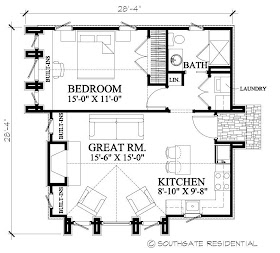Even thinking of my own homes, I could live quite comfortably with less. We have three guest rooms that are unlikely to ever be filled at the same time, a formal dining room that has been used, literally, twice, a morning room that I don't think I've ever sat down for a meal in. The first house I ever owned, though smaller, also had a guest room that was used a handful of times a year (and never by guests who would have been put out to sleep on a pull-out sofa) and a dining room used just as often.
Several times, I've put pen to paper (or mouse to autoCAD) trying to design a space that does exactly what it needs to do, and does it well, but no more. I'm not alone. Professionally, more and more clients are seeking quality versus quantity in their spaces. Part of this change has been driven by the challenging economy of the past few years. But, more than that, I think it's a desire for more intimate spaces, homes that are easier to keep, places where the owner can just enjoy being "home" and not spend all their time cleaning and maintaining spaces they don't need.
There are some extreme examples. CNN recently featured the story of a Japanese house that was built on a plot of land that had been sold as a parking space! There are a number of companies that specialize in tiny homes--some as small as 100 square feet.
For my own exercise, I designed a house that would suit a single person, or perhaps a couple. At just 680 square feet, it's one of the smallest houses I've ever designed. It's fully functional in a footprint scarcely larger than a two-car garage. A fully equipped kitchen (no designated dining area, but the island serves a dual function for prep and dining), a single bath, space for linens and laundry, and a comfortable bedroom with a generous closet. A wall of built-ins in the bedroom allows it to double as a home office. Vaulted ceilings in the main spaces make the house feel larger than it is, and a fireplace flanked by built-ins brings a level of detail to the great room.
Floor Plan
The exterior is a low-maintenance mix of stucco and stone under a standing seam metal roof. Large expanses of glass are seperated by stone piers inside and out, filling the house with light and capturing views.
Elevation



What a great (and very efficient) space!
ReplyDeleteI think small homes allow for more creativity as it requires the designer to put thought into every aspect of the design. I myself live in a studio apartment in an urban center, and while it admittedly took some getting used to, I now LOVE it and can't imagine living any other way.
ReplyDelete